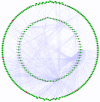Identification of differentially expressed non-coding RNAs and mRNAs involved in Qi stagnation and blood stasis syndrome
- PMID: 30679994
- PMCID: PMC6327641
- DOI: 10.3892/etm.2018.7068
Identification of differentially expressed non-coding RNAs and mRNAs involved in Qi stagnation and blood stasis syndrome
Abstract
Qi stagnation and blood stasis syndrome (QSBSS) is a common Zheng in Traditional Chinese Medicine (TCM), describes the condition of unsmooth flow of Qi and blood, which manifests as distending pain in a fixed body part and emotional disorders, including irritability and depression. However, the underlying molecular mechanisms remain largely elusive. RNAs are the connection between DNA and proteins, which reflect the interaction between the genotypes and the phenotype. Of note, non-coding (nc)RNA is a type of RNA that is not translated into any protein, but has regulatory functions. Despite the growing interest in exploring the biological basis of TCM Zhengs, the specific roles of ncRNAs in QSBSS have remained largely elusive. In the present study, next-generation sequencing was performed to investigate the ncRNA profile in patients with three different types of disease, but who had QSBSS. A total of 104 long non-coding RNAs, 2 circular RNAs and 697 mRNAs were identified to be significantly differentially expressed in QSBSS patients. Further bioinformatics analysis revealed that the most significantly enriched pathways by the differentially expressed RNAs in QSBSS were the sphingolipid signaling pathway, the neurotrophin signaling pathway, 5'AMP-activated protein kinase and endocytosis. In addition, a network pharmacology analysis indicated that several of the differentially expressed RNAs were included in the targets of TCM herbs for treating QSBSS. The present study was the first to identify ncRNAs that are deregulated in QSBSS by next-generation sequencing technology. The results may offer insight into the biological basis of TCM Zheng and the optimization of ancient formulae, as well as the discovery of novel drugs, to pave the way toward advanced TCM theory and improved health care delivery.
Keywords: Qi stagnation and blood stasis syndrome; Traditional Chinese Medicine; expression profiles; non-coding RNAs; sequencing.
Figures









References
-
- Zha LH, He LS, Lian FM, Zhen Z, Ji HY, Xu LP, Tong XL. Clinical strategy for optimal traditional chinese medicine (TCM) herbal dose selection in disease therapeutics: Expert consensus on classic TCM herbal formula dose conversion. Am J Chin Med. 2015;43:1515–1524. doi: 10.1142/S0192415X1550086X. - DOI - PubMed
-
- Wang YH, Xu AL. Zheng: A systems biology approach to diagnosis and treatments. Sci Art Sci Traditional Med (Suppl) 2014:S13–S15.
LinkOut - more resources
Full Text Sources
